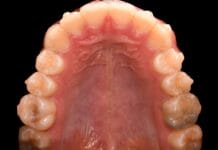Imagine that it is about 3 pm, and you have just finished a tough SRP. You walk your patient to the front, and she seamlessly gets checked out. You then have a quick chat with your coworker about her upcoming nuptials. After returning to your operatory and breaking it down and setting up, you realize that you need a little snack to finish the rest of your day, as well as some hydration to keep your brain functioning properly.
You grab a healthy yogurt out of the fridge and take a seat − all that delicious fruit going down leisurely, spoonful after spoonful. Snap out of it! That my friend was a dream, or you are reflecting back to 1995 when dentistry was so dramatically different, and the fruit on the bottom of yogurt was considered healthy.
The changes in the profession are profound, but our bodies have not changed a bit. We still need food and water to survive and function efficiently. Dentistry is now yielding to longer days, and some practices choose to not even take a lunch.
The idea is that you can just have a bite between patients. I love that theory.
Fighting the Growl of Hunger
We still need hydration for proper mind and body function. We still have hunger pains that we often dismiss and can cause a number of health problems. The brain triggers the release of a hormone called ghrelin in response to an empty stomach or in anticipation of the next meal. It signals the body to releases stomach acids to digest food. With no food, the stomach acids then begin to attack the lining of the stomach, causing the pains.
Ghrelin also interacts with insulin and falling levels of insulin cause ghrelin. Therefore, hunger levels rise. It’s no wonder that we crave sugary snacks when we are starving.
Lack of hydration can also cause a plethora of health concerns, including impairing cognitive function and reducing the delivery of oxygen throughout the body. Lack of food and water makes you hangry, lightheaded, and exhausted.
Granted, intermittent fasting and calorie restrictions have their place and even benefits. But a lack of breaks or nourishment during a workday most often is not a conscious decision made by you, the clinician. This isn’t an article to suggest kale chips as your go-to snack. If that’s your thing, more power to you. For me, kale is a work in progress.
The food industry came up with an energy bar phenomenon to help us in a pinch, but they are laden with processed junk and sugar. They may be great on the go, but homemade is much more nutritious. Time is our most precious resource that we all have too little of. Weekends are a wonderful opportunity to meal prep and make these lovely energy bars.
However, most of us don’t follow through. In case you are adventurous, here is a great recipe to try. It may be a tad labor-intensive, but you can store them in the fridge for a week or freeze for up to two months. So preparing a double batch one weekend would help. This is a vegetarian recipe and yields 10 servings. Add it to your child’s lunch and be “that Mom” that drives other Moms nuts.
No-bake Energy Bars
Ingredients:
- 2 cups oat bran
- 1 cup flaxseed meal
- 1/4 cup date crumbs
- 1/2 cup raw cacao
- 2 tablespoons maca powder
- 2 tablespoons spirulina
- 2 scoops 100% grass-fed chocolate whey protein powder
- 1 cup peanut butter (or almond butter)
- 1/2 cup coconut nectar
- 1 cup almond milk (use more milk for a softer batter)
- 1 tablespoon coconut oil
- 1/2 cup dark chocolate chips (you can use sugar-free)
Preparation:
- Line a 12 x 12-inch pan with parchment paper and set aside.
- In a medium-size bowl, mix together bran, flaxseed meal, date crumbs, raw cacao, maca powder, spirulina, and protein powder.
- In a small pot, combine your peanut butter (or nut/seed butter of choice) with coconut nectar (or other sticky sweetener) and melt over low heat. Mix well with a spatula. Add to dry ingredients.
- Add almond milk and mix until fully incorporated. I usually do it with my hands.
- Pour your peanut butter filling into the lined pan. Press and flatten with a spatula until evenly distributed. Place in the freezer for 20 minutes. Once firm, cut into 10 bars and place back in the freezer.
- Melt coconut oil and chocolate chips in a small pot over low heat (or, if in a hurry, microwave for approximately 30 seconds).
- Pour melted chocolate over the bars. Spread with a spatula until evenly coated. Once coated, place on a lined plate or tray and freeze until firm, about 20 minutes.
- Wrap each bar in parchment paper. Store in the fridge for a week or freeze for up to 2 months. Enjoy!
Now, let’s be me! Quick and easy − that’s the name of the game. Five terrific, fast office snacks to grab and go are below.
Brazil nuts
You can’t go wrong with any nuts and seeds, but brazil nuts are a powerhouse (of course, not the ones loaded with sugar and salt but as stripped of the added ingredients as you can get). Keep in mind the serving size and what a handful really looks like. One ounce of brazil nuts is six to eight kernels that equals 3.5 grams of carbs. Brazil nuts contain healthy fats, fiber, and protein. The fats that are in Brazil nuts are polyunsaturated fats (or PUFAs for short). PUFAs protect the brain cells in the long term. One study showed that eaters who consumed two grams of PUFAs a day had a 70% lower risk of Alzheimer’s than those who ate less.1
Another enormous benefit to Brazil nuts is selenium. This mineral is vital for the proper function of your body. It influences your thyroid, immune system, and cell growth.2 Higher levels of selenium have been linked to better cancer outcomes, infections, infertility, heart disease, and mood disorders.3
Chickpeas
For the life of me, it took me forever to put together that the sweet name chickpeas are the same food as garbanzo beans, which just sounds horrid. I am a lover of hummus, but I just don’t like the name garbanzo, I guess. One of the biggest benefits to these little nibbles is blood sugar control. Your body processes them slowly, and that helps with digestion.
They are also filled will soluble fiber. (Think more regular if you know what I mean.) They can also help with cholesterol, specifically LDL or bad cholesterol. Another bonus is they have calcium and magnesium, and that encourages stronger bones. I regretfully tend to neglect my calcium.
Lastly, they help with mental health, specifically due to choline, which is a nutrient that helps make important chemicals for memory, mood, and other nervous system activity.
Of course, you won’t probably be shoveling in chickpeas out of a can, but dried ones are really delicious. You can roast them yourself or buy a healthy prepackaged snack. I buy Biena – gluten-free, vegan, and dairy-free. Lots of varieties of flavor, but I would guess sea salt might be the healthiest. With the amount of sweating happening in the operatory, a little salt may not hurt.
Berries, Berries, and Berries
Lots of choices in the berry world. Blackberries, blueberries, strawberries, or raspberries, to round them out. They are packed with antioxidants that help fight free radical damage caused by oxidative stress that our body is under constant attack from. Think about free radicals as a waste product from the various chemical reactions in our body’s cells. Antioxidants keep them in check. Our stress level is heightened inside and outside the operatory, and psychological stress is known to predispose people to several diseases. Stress can diminish the effectiveness of the immune system and perhaps also the efficacy of the antioxidant system and repair processes.4
We need to help ourselves out a bit and make some preemptive strikes to combat damage. Another option to berries is goji, mulberries, and dark cherries. Gojis, in case you haven’t heard of them, is a bright orange, red berry that has been used to help with diabetes, blood pressure, and even eye problems. They can be eaten raw, cooked, and dried (similar to raisins). Be careful with goji if you are taking blood thinners, and they may interact with blood pressure and diabetic medications. As always, please check with your doctor.
Cranberries are tricky but yummy. First and foremost, raw and dried are two different beasts. One cup of raw is one serving, whereas a serving of dried cranberries is one-quarter cup. Dried berries have more sugar and twice the calories, half the fiber, twice the carbs, and, make no mistake, can have five times the sugar. Cranberries are, however, a superfood filled with phenols, the highest level of antioxidants (red grapes are a distant second). Cranberries also have a bit of antimicrobial strength to them as well as anti-inflammatory.
Apples
Easy peasy lemon squeezy. Talk about grab-and-go. One medium apple has four grams of fiber and contains pectin, a type of fiber that acts as a prebiotic. Go gut! Balancing your gut bacteria has been shown to help alleviate anxiety, stress, and depression.5 It’s a two-way street. As the gut microbiota mediates the stress response, stress can, in turn, alter the gut microbiota.6
If you are on a low carb diet, this may not be for you. Apples come in at 25 grams of carbohydrates. But they are a super-rich source of polyphenols and vitamin C. One of the polyphenols is the flavonoid epicatechin, which may also lower blood pressure.
Did you know that eating the apple with the skin reduces the net carbs in the apple? Apples are low glycemic, meaning they release sugar slowly into the bloodstream and provide nearly 20 percent of your daily fiber. If you eat the skin, choosing organic may be the best option. Apples are high in water and may help with some of our issues of hydration during our days. Red Delicious and Gala apples have the highest antioxidants and fiber.
Watermelon
Admittedly, this is a bias that I am obsessed with. Granted, you can’t exactly drop them in your pocket, but watermelons are delightful and packed with water − 92% to be exact. One cup is equal to five ounces of water. Watermelons have an anti-cancer compound, lycopene, that in animal models has been found to have a therapeutic role against oxidative stress, cardiovascular disease, and diabetes.7 Lycopene may also help keep eyes healthy and protect against age-related macular degeneration.
Other vitamin benefits include vitamin C that helps with free radical damage, vitamin A, potassium, magnesium, and vitamin B1, B5, B6. Watermelon contains citrulline, an important nonessential amino acid. Citrulline is often used to ramp up athletic performance when supplemented. (I, for one, feel that dentistry is an actual Olympic sport.) L-citrulline plays a role in preventing high blood pressure and helps to build L-arginine that is responsible for maintaining proper artery function.
Studies have shown that one to two grams of citrulline per day can lead to an increase in serum arginine levels that leads to more nitric oxide. Nitric oxide is one of the most crucial molecules when it comes to healthy blood vessels. Granted, watermelon is high in fructose but really one cup? Natural sugars and carbs, yes, but fewer calories and the glycemic load of watermelon is only five.
Keeping ourselves healthy is the biggest gift you can give yourself and your family. My Mom (as well as most mothers) says, “If you don’t have your health…,” and she is so right. You deserve only the best. I want to include a final recipe that is worth throwing together on the weekend.
Brain Healthy Trail Mix
Ingredients:
- ½ cup raisins
- ½ cup date crumbles
- ¼ cup sunflower seeds
- ¼ cup pumpkin seeds
- ¼ Brazil nuts
- ¼ cup goji berries
- ¼ cup roasted hazelnuts
- ½ cup halved walnuts
- ½ cup unsweetened coconut flakes
- ½ cup unsweetened cacao nibs
- ¼ cup pistachios, shelled
- ½ cup sliced almonds
- ¼ cup hemp hearts
- ½ cup unsweetened banana chips
Preparation:
Combine all the ingredients and stash the mix in an airtight container. It will keep in the refrigerator for two weeks. Serves 12.
Before you leave, check out the Today’s RDH self-study CE courses. All courses are peer-reviewed and non-sponsored to focus solely on high-quality education. Click here now.
Listen to the Today’s RDH Dental Hygiene Podcast Below:
References
- Morris, M.C., Evans, D.A., Bienias, J.L., et al. Dietary fats and the risk of incident Alzheimer disease [published correction appears in Arch Neurol. 2003 Aug; 60(8): 1072]. Arch Neurol. 2003; 60(2): 194-200. doi:10.1001/archneur.60.2.194. Retrieved from https://pubmed.ncbi.nlm.nih.gov/12580703/.
- Lacka, K., Szeliga, A. Significance of selenium in thyroid physiology and pathology. Pol Merkur Lekarski. 2015; 38(228): 348-353. https://pubmed.ncbi.nlm.nih.gov/26098657/.
- Rayman, M.P., Rayman, M.P. The argument for increasing selenium intake. Proc Nutr Soc. 2002; 61(2): 203-215. doi:10.1079/PNS2002153. Retrieved from https://pubmed.ncbi.nlm.nih.gov/12133202/.
- Halliwell, B., Gutteridge, J. Free Radicals in Biology and Medicine. 3rd edition. Oxford, UK: Clarendon Press; 1999.
- Gur, T.L., Worly, B.L., Bailey, M.T. Stress and the commensal microbiota: importance in parturition and infant neurodevelopment. Front Psychiatry. 2015; 6: 5. doi:10.3389/fpsyt.2015.00005. Retrieved from https://pubmed.ncbi.nlm.nih.gov/25698977/.
- Bharwani, A., Mian, M.F., Foster, J.A., Surette, M.G., Bienenstock, J., Forsythe, P. Structural & functional consequences of chronic psychosocial stress on the microbiome & host. Psychoneuroendocrinology. 2016; 63: 217-227. doi:10.1016/j.psyneuen.2015.10.001. Retrieved from https://pubmed.ncbi.nlm.nih.gov/26479188/.
- Naz, A., Butt, M.S., Sultan, M.T., Qayyum, M.M., Nia,z R.S. Watermelon lycopene and allied health claims. EXCLI J. 2014; 13: 650-660. Retrieved from https://www.ncbi.nlm.nih.gov/pmc/articles/PMC4464475/.











